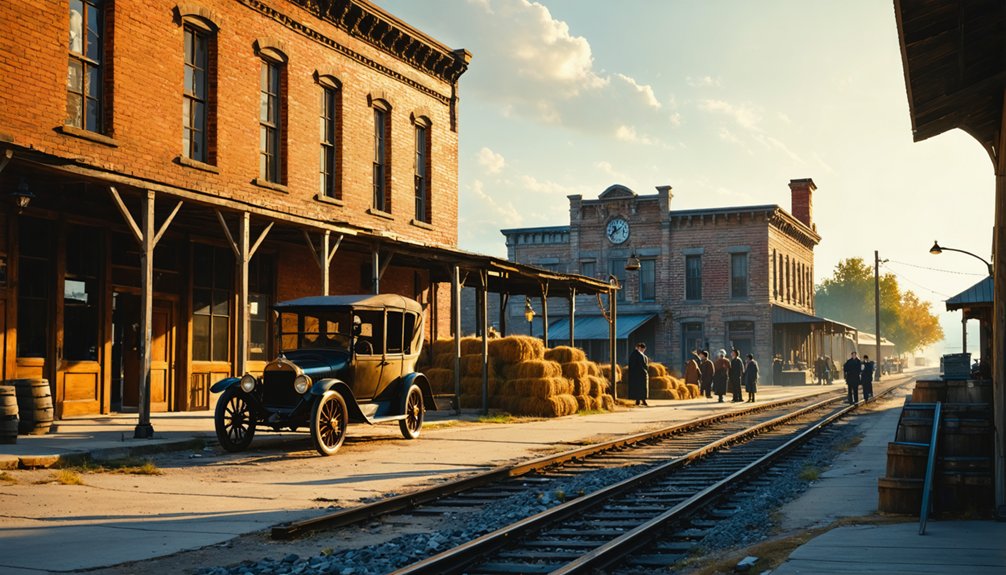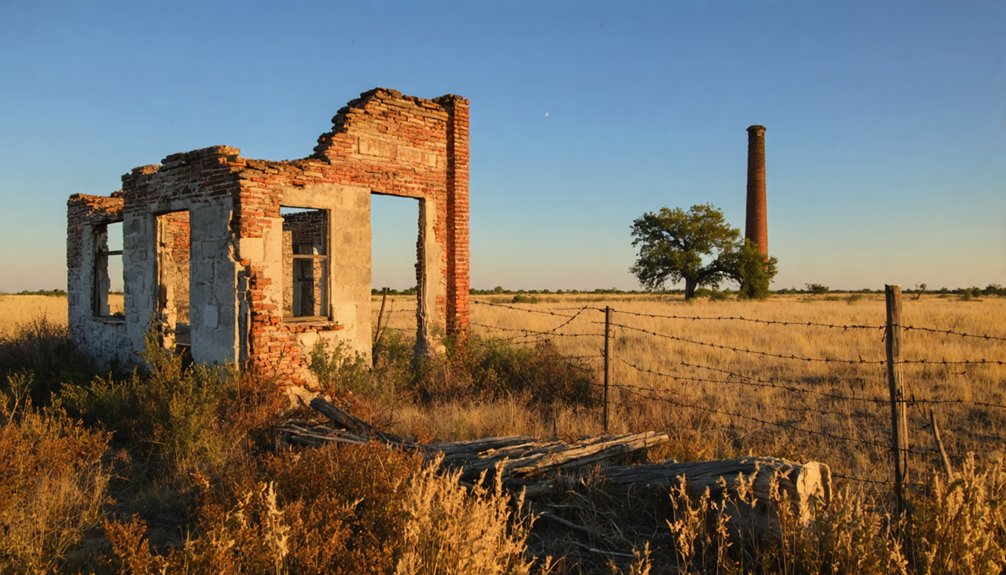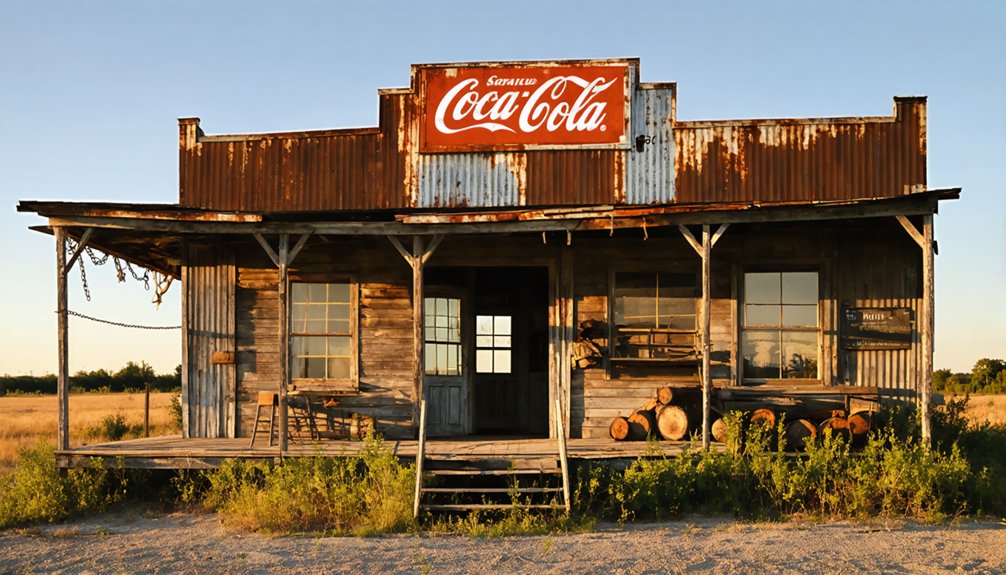You’ll find Birchville, Texas as a ghost town that began in 1857 as Smith Ranch Station on the San Antonio-San Diego Mail Line. It served as an essential stagecoach stop operated by George Lyles, featuring an eating house and horse-changing station. The town’s decline started with railroad expansion in the late 1800s, leading to its eventual abandonment. Today, only scattered foundations remain in the harsh landscape, with off-road vehicles needed to explore its forgotten frontier story.
Key Takeaways
- Birchville began as Smith Ranch Station in 1857, serving as a crucial stagecoach stop on the San Antonio-San Diego Mail Line.
- The town declined after railroad expansion redirected trade and travel routes away from Birchville in the late 1800s.
- George Lyles operated the station’s eating house and managed horse changes for travelers along the Butterfield Overland Mail route.
- No standing structures remain today, with only scattered foundations and rubble marking the ghost town’s former location.
- The site requires off-road vehicle access and has largely returned to wilderness, with extreme weather accelerating artifact decay.
The Rise of a Frontier Settlement
While many frontier settlements emerged along Texas mail routes in the 1850s, Birchville began its journey as Smith Ranch Station in 1857, serving as an important stop on the San Antonio-San Diego Mail Line. Similar to how European exploration shaped early developments in other regions, the first settlers brought significant changes to the landscape.
You’ll find the settlement dynamics centered around its role as a stagecoach station, particularly after joining the Butterfield Overland Mail route in 1858. Under George Lyles’ operation, the station became a significant hub where travelers could rest, eat, and change horses. Like many settlements that were bypassed by railroads, the town’s significance gradually diminished as newer transportation methods emerged.
The mail logistics of Birchville proved fundamental to the region’s development. With a dedicated staff including Lyles’ family and a cook, the station maintained its position as a key relay point in West Texas’s transportation network, demonstrating how frontier outposts could establish themselves through critical services.
Life Along the San Antonio-El Paso Road
The San Antonio-El Paso Road shaped frontier life far beyond Birchville’s mail station operations, stretching across 600 miles of Texas territory from 1849 to 1882.
You’d find military forts strategically positioned along the route, including Forts Clark, Lancaster, and Davis, where soldiers maintained vigilance against raids and protected crucial supply lines. Butterfield Overland Mail service later utilized this vital pathway for its operations.
Road conditions challenged even the hardiest travelers as they navigated the rugged Edwards Plateau and crossed the perilous Pecos River. Pack-mule trains proved more effective than wagons, with fifty mules capable of transporting 12,500 pounds of cargo across difficult terrain.
Six-mule wagon teams hauled up to 3,300 pounds of cargo, while military supply chains sustained frontier settlements.
The road’s presence drew more than just mail carriers – it attracted emigrants bound for California’s goldfields, commercial freighters moving goods, and ranchers establishing new operations.
This essential artery of commerce continued serving the region until railroad expansion in the 1880s.
Early Ranching and Farming Legacy
As you travel along the old San Antonio-El Paso Road near Birchville, you’ll find remnants of ranching operations that relied on the Rio Grande’s water supply for cattle and crops.
Similar to Capt. Blas Maria de la Garza Falcon’s Rancho Carnestolendas operation in 1752, the area’s early ranch families followed traditional Spanish and Mexican grazing patterns, moving livestock between riverside pastures and upland ranges depending on seasonal conditions.
Small family farming operations dotted the landscape alongside larger cattle ranches, taking advantage of the river valley’s fertile soil despite the region’s challenging climate. The area’s ranching practices were heavily influenced by Mexican vaqueros, who introduced essential cattle-handling techniques that shaped early Texas ranching culture.
Ranch Life Along Road
Many early ranches along Birchville’s roads traced their roots to 18th-century Spanish mission settlements, where cattle operations laid the groundwork for Texas’s ranching heritage.
You’d find ranch hands from diverse backgrounds working together – Swedish immigrants alongside skilled vaqueros who owned their own gear and worked independently. The SMS brand ranchers, led by Svante Swenson, were among the first registered cattle brands in Texas.
The roads connected essential ranch infrastructure, including stations like Smith Ranch that served as rest stops for stagecoaches and mail routes.
You’ll notice how ranches strategically positioned themselves near reliable water sources, with fortified structures protecting against raids. Ranch owners built earthen dams and holding tanks to ensure a steady water supply for their herds.
The Swenson Ranch exemplified this development with its barns, corrals, and drilled wells.
These operations weren’t just about cattle – they maintained remuda herds of Spanish-Arabian mixed horses and introduced improved cattle breeds like Durham Shorthorns and Herefords.
Water and Grazing Patterns
Reliable water sources shaped Birchville’s early ranching operations, with groundwater from the Seymour aquifer and natural springs proving essential for sustained agriculture.
You’ll find early ranchers developed strategic grazing patterns around these precious water points, moving their herds between wells and springs to prevent overgrazing while maximizing available resources.
Water conservation became critical to survival, as ranchers tapped artesian wells and created stock tanks to collect runoff. They’d carefully plan their cattle drives along routes with dependable water access, particularly during drought periods.
The aquifer’s irregular distribution, with its mix of wet and dry holes, forced ranchers to adapt their grazing strategies constantly.
When the devastating Rio Grande flood of 1867 hit, it destroyed many water sources, fundamentally altering established grazing patterns and contributing to Birchville’s eventual decline.
Like many Texas towns that relied on groundwater, Birchville faced significant challenges as groundwater availability decreased over the decades, making it harder to sustain large-scale ranching operations.
Family Farming Operations
While Anglo settlers initially established large cotton plantations across Texas, Birchville’s agricultural legacy centered on smaller family-operated farms and ranches.
You’ll find that these family operations relied heavily on family labor, with everyone pitching in to maintain both crops and livestock. Many farmers supplemented their income through tenant systems, sharing crop proceeds with landowners. Following the practices of Texas A&M University, local farmers increasingly adopted scientific farming methods to improve their yields.
Life on Birchville’s family farms typically included:
- Growing subsistence crops like corn, wheat, and oats to feed both family and livestock
- Raising cattle supported by grain cultivation, with growing importance of poultry production
- Adapting to harsh conditions through crop diversification, including drought-resistant sorghum and cantaloupe
This mixed farming approach continued until post-WWII mechanization gradually replaced traditional labor practices, though smaller operations maintained labor-intensive methods longer than larger farms.
The Town’s Peak Years and Daily Life

You’ll find Birchville’s peak years marked by its crucial role as a Butterfield Overland Mail station from 1858 to 1861, where station agent George Lyles and his staff maintained horses and provided meals to weary travelers.
The daily rhythm of life centered around the stagecoach schedule, with the station’s eating house serving as a hub for both passengers and mail carriers passing through on the San Antonio-San Diego route.
The station’s strategic location along the Rio Grande made it an important supply point during the Civil War, when Lyles traded mesquite beans with Union forces stationed at nearby Franklin.
Ranch Operations 1880-1890
During the peak years of 1880-1890, Birchville’s ranch operations exemplified the classic West Texas cattle industry, with operations scattered along the Rio Grande tributaries where water access proved essential.
Ranch management centered around large herds of longhorn cattle, with skilled foremen directing daily activities while adapting to the harsh environment.
You’d find these critical elements of livestock care in action:
- Cowboys moving cattle between floodplain and upland grazing areas to maximize pasture use
- Ranch hands maintaining essential infrastructure like corrals, barbed wire fencing, and windmills
- Workers conducting seasonal cattle drives to market, often coordinating with buyers and transport networks
The ranches supported themselves through cattle sales, supplemented by providing beef to nearby stagecoach stations and military outposts, with some additional income from hide and tallow production.
Life Along Trading Route
As a bustling stop along the San Antonio-El Paso Mail Line from 1857, Birchville transformed into an essential trading hub where stagecoach passengers, mail carriers, and traders converged.
You’d find station agent George Lyles running both the mail operations and a grocery, while an eating house provided meals to weary travelers crossing the challenging Trans-Pecos region.
The trade dynamics centered on horse changes, supply distribution, and rest services. Within the station community, you’d see a well-organized operation where staff managed daily tasks from food preparation to horse care.
Life wasn’t easy – the isolated location and dangerous route demanded resilience from residents. Station activities peaked during the Butterfield Overland Mail years until 1861, then revived briefly with the San Antonio-El Paso Mail in 1866, before the devastating Rio Grande flood of 1867 ended Birchville’s role forever.
Factors Behind the Decline
While many ghost towns succumbed to sudden disasters, Birchville’s transformation into a ghost town stemmed from multiple interconnected factors that slowly eroded its viability.
The town’s decline began with critical transportation changes and economic shifts, as the closure of its railroad depot redirected trade to neighboring communities.
You’ll find three key factors that sealed Birchville’s fate:
- Loss of the railroad stop forced businesses to relocate, including the general store and bank.
- Young residents left for urban opportunities, leaving behind an aging population unable to sustain local services.
- Without essential services, remaining families had to travel further for basic needs, accelerating the exodus.
The combination of transportation decline, dwindling population, and loss of crucial services created a downward spiral from which Birchville couldn’t recover.
Remaining Traces and Ruins Today

The barren landscape of modern-day Birchville offers few remnants of its past as a bustling stagecoach stop. You’ll find no standing structures in this remote Hudspeth County ghost town – just scattered foundations and rubble slowly eroding into the desert soil.
Without archaeological findings to document the site’s material culture, most traces of the former Butterfield Overland Mail station have vanished.
Desert preservation challenges have taken their toll, with extreme temperatures and harsh conditions accelerating the decay of any wooden or metal artifacts.
The site’s difficult access and lack of maintained roads or markers means you’ll need an off-road vehicle to explore what’s left.
Unlike some West Texas ghost towns that retain partial buildings, Birchville has largely returned to open land, its ruins gradually disappearing into the surrounding wilderness.
Historical Significance in West Texas
Located in present-day Hudspeth County, Birchville emerged from humble beginnings as Smith Ranch to become an essential waypoint during West Texas’s frontier development.
The settlement’s cultural exchange flourished through community dynamics that shaped the region’s identity and resilience.
You’ll find Birchville’s historical impact reflected in three key aspects:
- It served as a crucial hub for ranchers, travelers, and traders moving through the borderlands.
- The town fostered unique social connections through taverns and informal gatherings.
- It exemplified the self-sufficient spirit of frontier settlements adapting to harsh conditions.
As a reflection of West Texas’s ranching heritage, Birchville’s story captures the essence of freedom and determination that defined the American frontier experience in Hudspeth County.
Frequently Asked Questions
How Safe Is It to Visit Birchville’s Ruins Today?
Better safe than sorry – you shouldn’t visit without following essential safety precautions. There’re no official visitor guidelines, unstable structures, limited emergency access, and numerous environmental hazards in these remote ruins.
Are There Any Documented Paranormal Activities or Ghost Stories From Birchville?
You won’t find documented ghost sightings or haunted locations in Birchville’s history. Unlike other Texas ghost towns that boast paranormal activity, there aren’t any verified supernatural reports from this site.
What Native American Tribes Originally Inhabited the Birchville Area?
You’ll find the Tonkawa tribe was mainly settled in this area, while Comanche warriors moved through later. The Waco and Tawakoni tribes also shared this Native American tribal history.
Can Visitors Legally Collect Artifacts From the Birchville Site?
Like sands through history’s hourglass, you can’t legally gather artifacts without permits. Legal regulations and artifact preservation laws protect the site – you’ll need official authorization to collect anything.
Which Descendants of Original Birchville Settlers Still Live in Hudspeth County?
You’ll find Saffarrans and Smith family descendants maintaining local heritage through ranching in Hudspeth County today, though specific settler genealogy details are protected for their privacy and independence.
References
- https://www.loquis.com/fr/loquis/10747285/Birchville+Texas
- https://alchetron.com/Birchville
- https://texashighways.com/travel-news/four-texas-ghost-towns/
- https://en.wikipedia.org/wiki/List_of_ghost_towns_in_Texas
- https://cedarbayoumarina.com/four-ghost-towns-under-lake-texoma/
- https://theforgottensouth.com/toyah-texas-ghost-town/
- https://www.texasescapes.com/TexasGhostTowns/RaynerTexas/RaynerTx.htm
- https://texaswanderers.com/category/historic/ghost-towns-history/
- https://texascooppower.com/south-texas-lost-ghost-town-of-linnville/
- https://www.youtube.com/watch?v=Zd8-gKw-5Hc



